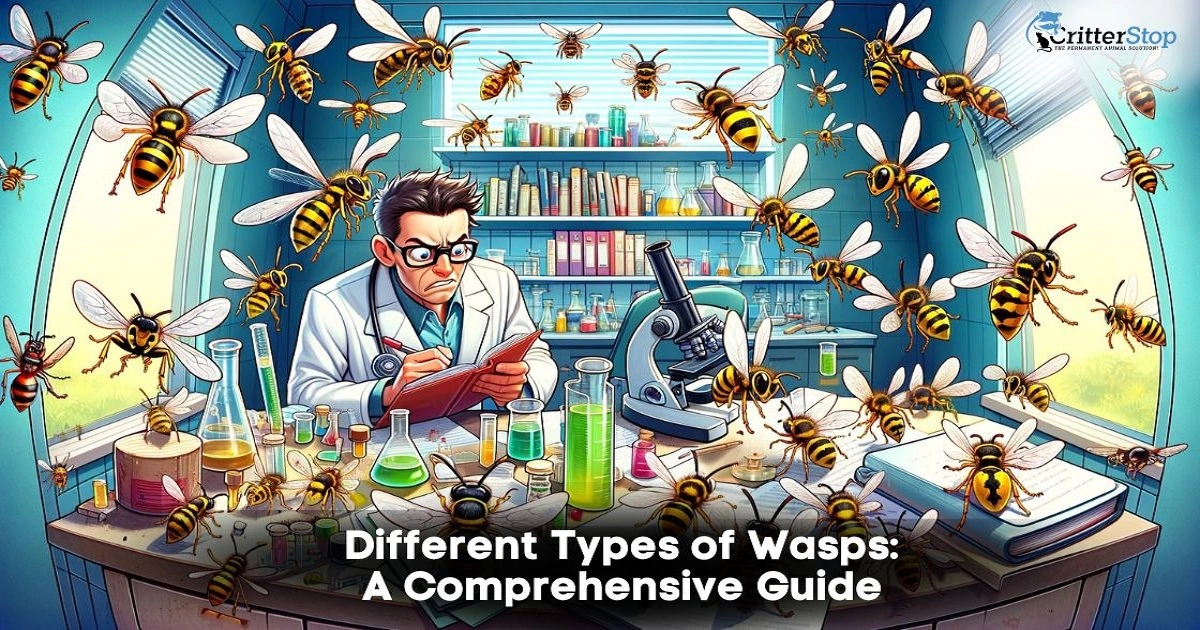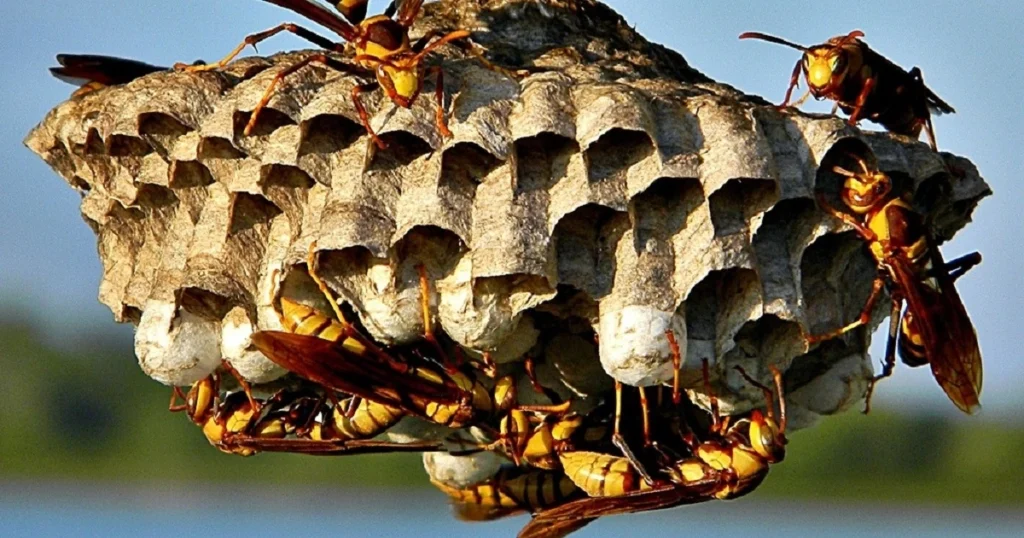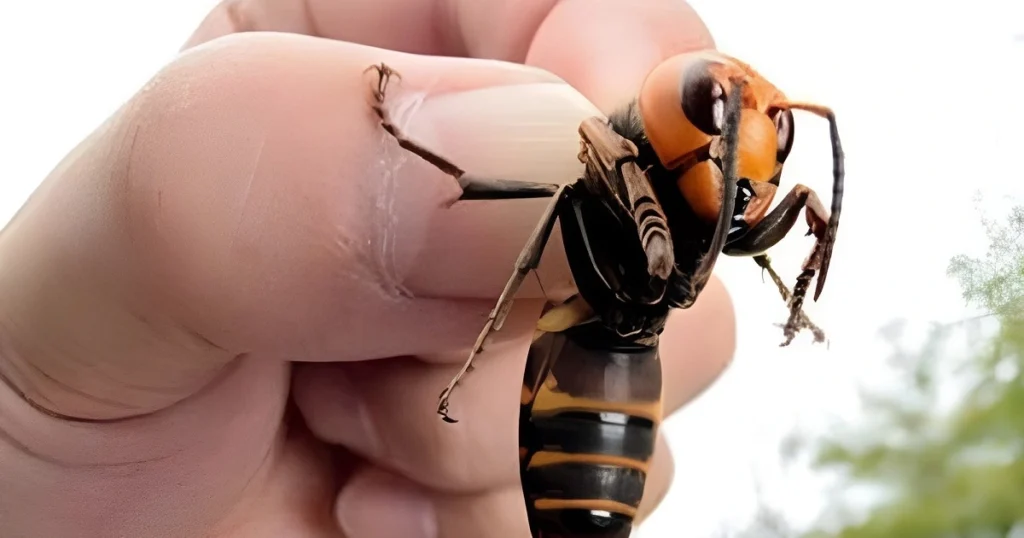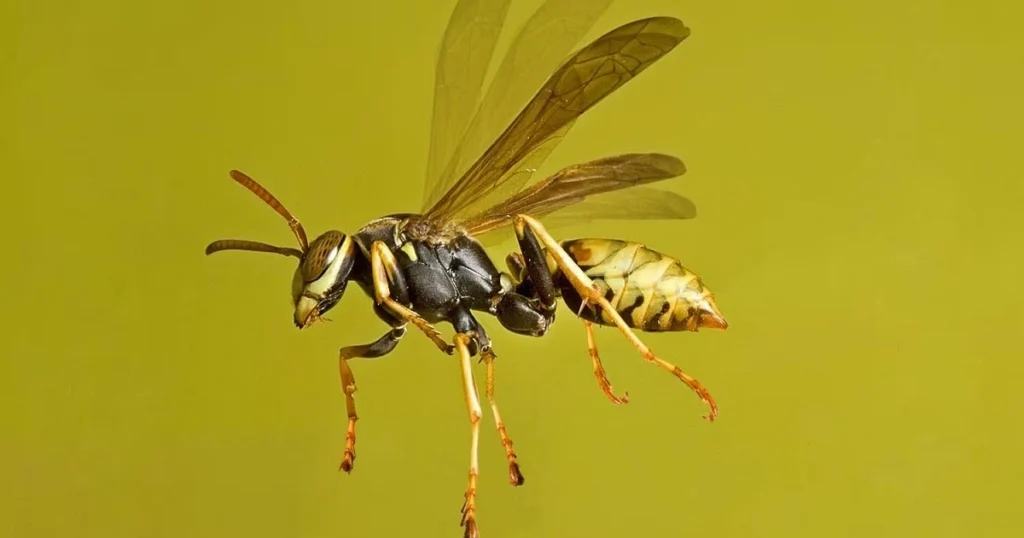
Wasps are a peculiar group of insects belonging to the Hymenoptera order, which also covers bees and ants. With over 30,000 identified species worldwide, it's safe to say there are many different types of wasps, each with unique characteristics and behaviors. Although wasps are often feared and misunderstood, they play an essential role in the ecosystem as pollinators and predators, just like honey bees.
The first well-known type of wasp is the yellow jacket. These social insects are commonly found in North America and are known for being extremely aggressive when guarding their nests. Yellow jackets can be identified by their yellow and black striped bodies and can sting multiple times, making them a hazard to humans and pets. However, they also play an important role in controlling populations of other insects, such as caterpillars and flies; unlike bees, wasps are predators.
Another type of wasp is the paper wasp, which is known for its distinctive thin waist and long legs. Paper wasps are social insects that build nests out of paper-like material, often in sheltered areas such as under eaves or in trees. Although they can be territorial and will defend their nests if threatened, they are generally less aggressive than yellow jackets. Paper wasps are important pollinators and also help control populations of other insects.

Different types of wasps have a similar life cycle. Wasps begin their life as eggs, which are laid by the queen wasp. Once hatched, the wasp larvae feed on insects and other prey that the adult wasps bring to them. After several weeks, the larvae will spin cocoons and pupate. Finally, adult wasps emerge from the cocoons and continue the life cycle.
Wasps have a distinctive body structure that sets them apart from other insects. They have three body segments: the head, thorax, and abdomen. The head contains its eyes, a set of antennae, and mouthparts. The thorax contains the wasp's wings and legs. The abdomen contains the wasp's reproductive organs and venom glands.
To identify different types of wasps, it is important to look at their body structure and color. Wasps can be black, brown, yellow, or a mixture of these colors. Some stand out due to their unique palettes, like cuckoo wasps, which are blue. Some wasps, like the European hornet, have stripes or spots on their bodies, while others have solid colors.
Remembering these wasp fundamentals and using a wasp identification chart can help identify different wasps.
Wasps belong to the order Hymenoptera. There is a vast catalog of wasps, each with unique characteristics and behaviors. In this section, we discuss some of the most common wasp families.
The Vespidae family includes many different types of wasps and hornets. These insects are known for their distinctive black and yellow striped bodies. The most common types of wasps in this family include yellow jackets, paper wasps, and hornets.
Yellow jackets are social wasps living in larger colonies. They are often found near garbage cans and other sources of food. Paper wasps are also social insects that build small, papery nests. Hornets are bigger than yellow jackets and paper wasps, and their claim to fame is their painful stings.
The Pompilidae family includes a group of wasps known as spider wasps. These wasps are known for their hunting behavior. They hunt spiders and other insects, which they paralyze with their venomous sting. The wasp then lays an egg on the prey, which will be used as a source of food for the developing larva.
The Sphecidae family includes a group of wasps known as digger wasps. These wasps are known for their burrowing behavior. They dig tunnels in the ground, which they use as nests for their eggs. Some species of digger wasps hunt other insects, with the velvet ant being one of their favorite dishes, while others feed on nectar.
Overall, there are many different types of wasps and European hornets, each with unique characteristics and behaviors. Understanding the different wasp families can help you gain a better insight into these insects.

Wasps are a diverse group of insects with different physical and behavioral traits. Identifying them can be challenging, but with the right knowledge, it is possible to distinguish one species from another. In this section, we will discuss the different wasp varieties, visual identification, and behavioral traits that can help identify these insects.
Humanity has cataloged over 30,000 species of wasps, each featuring unique characteristics. The most common types of wasps include paper, yellow jackets, hornets, and mud daubers. Paper wasps are the most common. They are slender, and have long legs with a narrow waist. Yellow jackets are black and yellow with a stout body and a distinct waist. Hornets are similar to yellow jackets but are larger and have a brownish-red color. Mud daubers are long and slender with a narrow waist and a metallic blue-black color.
To help identify wasps, it is essential to have a wasp identification chart or a wasp nest identification chart. These charts provide images of different predatory wasp species and their nests, making it easier to identify them.
Visual identification is a crucial aspect of identifying wasps. Wasps have distinct physical characteristics that can help in their identification. These characteristics include body shape, color, and size. Some wasps are brightly colored, while others have a more muted coloration. Some wasps have a smooth body surface, while others have a hairy or spiny surface.
To identify wasps visually, it is essential to observe their body shape, color, and size. For example, paper wasps have slender bodies with long legs and a narrow waist. They are usually brownish-red or black. Yellow jackets have a stout body with a distinct waist and are black and yellow. Hornets are bigger than yellow jackets and feature a brownish-red color. Mud daubers are long and slender with a narrow waist and a metallic blue-black color.
Behavioral traits can also help in identifying wasps. Different wasp species have unique behaviors that can aid in their identification. For example, paper wasps are known for building their nests in sheltered areas such as eaves, while yellow jackets build nests in the ground or wall voids. Hornets build their nests in trees or shrubs, while mud daubers build them with mud.
To identify wasps based on their behavior, it is essential to observe their nest-building habits and their foraging behavior. For example, paper wasps are known for foraging on flowers and other plants, while yellow jackets are known for scavenging for food. European hornets are predators and feed on other insects, while mud daubers are parasitic and lay their eggs in the nests of other insects.
In conclusion, identifying wasps can be challenging, but with the right knowledge, it is possible to distinguish one species from another. By using a wasp identification chart, observing their physical characteristics, and understanding their behavioral traits, it is possible to identify different wasp species accurately.

The most famous insects in the order Hymenoptera are known for their stingers and ability to cause painful stings. However, not all wasps are aggressive and harmful. In fact, wasps play an important role in pollination and pest control. There are different types of wasps, including solitary and social wasps.
Solitary wasps are types of wasps that live alone and do not form colonies. They are typically non-aggressive and do not sting unless provoked. Solitary wasps are important for pest control as they hunt and kill other insects to feed their young. Some common examples of solitary wasps include mud daubers, cicada killer wasps, and spider wasps.
Social wasps are all types of wasps that live in colonies and work as teams to build nests and care for their young. They are typically more aggressive than solitary wasps and can sting multiple times. Social wasps are important for pollination and pest control. Some common examples of social wasps include yellow jackets, paper wasps, and hornets.
Overall, there are many different types of wasps, each with their own unique characteristics and behaviors. Understanding the differences between these types of wasps can help people appreciate their important role in the ecosystem and avoid unnecessary conflicts with them.

Wasps are a diverse group of insects that can be found in a variety of habitats. Understanding the different habitats that wasps occupy can help people identify and avoid them, as well as appreciate their role in the ecosystem.
Many species of wasps can be found in urban environments. They are often attracted to areas with a lot of human activity, such as parks, picnic areas, and outdoor restaurants. Some species, such as paper wasps and yellow jackets, build nests in and around buildings.
Wasps also occupy a range of natural habitats, including forests, grasslands, and wetlands. Some species, such as mud daubers, build their nests in soil or on rocks, while others, such as cicada killers, burrow into trees. Many species of wasps are also important pollinators and can be found visiting flowers in various habitats.
Overall, wasps can be found in a wide range of habitats, from urban areas to natural environments. Understanding the different types of wasps and where they are likely to be found can help people appreciate their role in the ecosystem and avoid unwanted encounters.

Some individuals find the distinctive painful stings of wasps dangerous. In this section, we will discuss human-wasp interactions, including wasp stings and wasp control.
Different types of wasps have different types of stingers, but all of them can cause pain, swelling, and redness. The are people allergic to wasp venom, which can cause anaphylaxis, a life-threatening allergic reaction. You must seek medical attention if you experience symptoms such as difficult to breath, face or throat swelling, or rapid heartbeat after a wasp sting.
To avoid wasp stings, it’s recommended to stay away from their nests and to not swat at them. Wearing protective gear, such as net suits of long sleeves and pants, can help prevent stings. If you get stung, you must remove the stinger as soon as possible and apply a cold compress to reduce swelling.
If you have a wasp infestation on your property, you must take action to keep it in control. Different types of wasps require different methods of control. For example, paper wasps can be controlled by removing their nests, while yellow jackets may require professional extermination.
Preventative measures such as sealing cracks and holes in your home, removing food sources, and keeping garbage cans tightly sealed can also help prevent wasp infestations.
In conclusion, being aware of wasp stings and taking preventative measures can help reduce the risk of negative human-wasp interactions. If you do experience a wasp sting or have a wasp infestation, seek professional help if necessary.

Wasps are often misunderstood and feared by people due to their stings, but science has proven they play a crucial role in the ecosystem as natural pest controllers. As such, it is crucial to conserve and protect the different types of wasps.
One way to support wasp conservation is to provide suitable habitats for them. Some wasps, such as paper, build their nests in sheltered areas such as under eaves, while others, such as mud daubers, construct their nests from mud. By leaving some areas of the garden or yard undisturbed, you can provide a suitable habitat for wasps to nest.
Another way to conserve wasps is by avoiding the use of pesticides. Pesticides not only kill harmful insects but also beneficial ones such as wasps. This can have a negative impact on the ecosystem as a whole.
It’s essential that people keep learning about wasps and their role in nature. By raising awareness, people can appreciate wasps' role in the ecosystem and take steps to protect them.
Overall, conserving wasps is crucial to maintaining a healthy ecosystem. By providing suitable habitats, avoiding pesticides, and educating people about their importance, we can help protect these beneficial insects.
Wasps are a common sight during the warmer months. While some people appreciate their role in controlling pest populations, others may find themselves dealing with unwanted wasp nests on their property. It's important to understand the different types of wasps to address any concerns related to these stinging insects effectively.
Each type of wasp has unique characteristics and behaviors, from aggressive yellow jackets to docile paper wasps. In this comprehensive guide, we'll explore the various types of wasps and provide insights into managing and preventing conflicts with these insects.
When dealing with a wasp infestation, it's crucial to seek professional assistance to ensure a safe and effective resolution. Critter Stop is a professional humane wildlife removal company and a trusted expert handling wasp problems.
With a fantastic reputation and glowing customer reviews online, Critter Stop is known for providing high-quality work and great customer service. By calling Critter Stop at (214) 234-2616 or contacting them through their website, property owners can rest assured that their wasp issue will be expertly addressed.
Whether it's the aggressive nature of yellow jackets or the distinctive umbrella-shaped nests of paper wasps, understanding the behavior and habits of different types of wasps is essential for effective management.
With Critter Stop's expertise and professionalism, property owners can confidently address any wasp-related concerns, ensuring a safe and pest-free environment. Don't hesitate to reach out to Critter Stop for reliable assistance in dealing with wasp problems on your property.
There are many different types of wasps found in nature, including paper wasps, yellow jackets, hornets, and mud daubers. These wasps can vary in size, color, and behavior.
To identify different wasp species native to California, one can observe their physical characteristics, such as color, size, and shape. It is also helpful to observe their behavior, nesting habits, and preferred habitats.
Wasps and hornets can be distinguished by their physical characteristics. Wasps tend to have a slender body with a narrow waist, while hornets have a thicker body with a wider waist. Additionally, hornets are typically larger than wasps.
The yellow jacket is known for being the most aggressive species of wasp. It is highly territorial and will aggressively defend its nests if it feels threatened.
Wasp nests can vary in size and shape depending on the species. They are typically made of paper-like material and can be found in trees, bushes, or on the sides of buildings. Some nests can be small and compact, while others can be large and sprawling.
The behaviors of small wasps and larger wasp species can differ based on their size and nesting habits. Smaller wasps tend to be less aggressive and are often solitary, while larger wasps are more social and can be highly territorial. Additionally, smaller wasps may build their nests in small crevices or holes, while larger wasps tend to build their nests in more open areas.
Visit our Critter Library and learn more about our furry friends